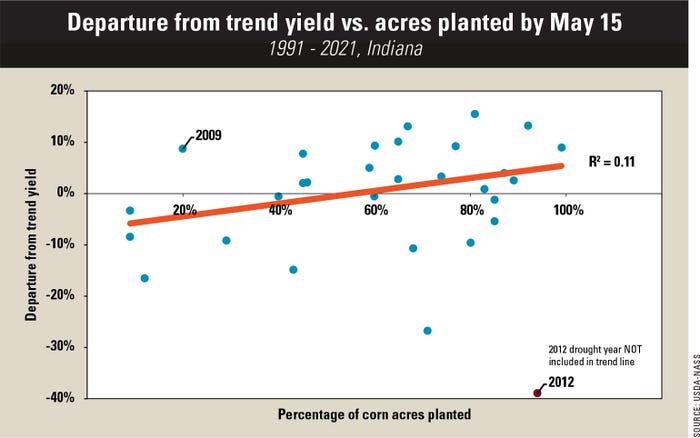
Maybe you’re determining how much corn to forward-contract for fall delivery. If you experienced planting delays, listen to what Bob Nielsen says before discounting yields based strictly on planting date. Nielsen is a Purdue Extension corn specialist.
Conventional wisdom says that if you want the highest possible corn yields, plant in the window opening about April 20 and closing about May 10. In southern Indiana, the window traditionally opens a week earlier, and in northern Indiana, a week later. Nielsen doesn’t intentionally look for holes in so-called logic, but he examines what data says and asks questions. Sometimes that leads to different conclusions than what most people believe.
“What we find from historical data is that early planting favors higher yields, but it doesn’t guarantee higher yields,” Nielsen says. “Statewide averages for planting progress and yield are not strongly related when you look at data.
“What historical data proves is that there must be many factors impacting yield potential in any one season. Planting date is just one of them.”
Closer look
“Analysis of USDA-NASS crop progress reports over the past 31 years indicates there is not a strong relationship between planting date and absolute yield,” Nielsen says. “There is not even a strong relationship between planting date and percent departure from trend yield on a statewide basis for Indiana.”
Nielsen plotted percent departure from trend yield against both percent of total corn acres planted by April 15 and percent of total corn acres planted by May 15 for the past 31 years.

“You can pick out mathematical trend lines, but they only account for about 10% to 11% of the variability in trend line departure from normal year to year,” he says. “This means that the relationship between planting date and corn yield is very weak. It underscores the fact that a number of other factors besides planting date affect yield in any given year.”
Year by year
Nielsen acknowledges that relative yield potential for corn declines about 0.3% per day beginning May 1 and increases to 1% per day by late May. He notes that a combination of factors — including a shorter growing season and higher risk of hot, dry weather during pollination — causes relative yield potential to decline with delayed planting.
However, early-planted corn in one year can yield more than, equal to or less than late-planted corn in another year, Nielsen says. “It all depends on the exact combination of yield-influencing factors in any given year,” he says.
Here’s a recent example. Nielsen notes that 2009 and 2012 represent late and early planting-date years, respectively. About 94% of Indiana’s corn crop was planted by May 15, 2012. In 2009, only 20% was planted by May 15. Yet in 2012, because of early drought and excessive heat, Indiana’s corn yield was 38.6% below trend yield. In 2009, final corn yield was 9.5% above trend yield, despite a late planting season.
“This was possible because there were other important yield-limiting factors in these two years than simply planting dates,” Nielsen concludes.
Learn more by reading The Planting Date Conundrum for Corn.
About the Author(s)
You May Also Like




